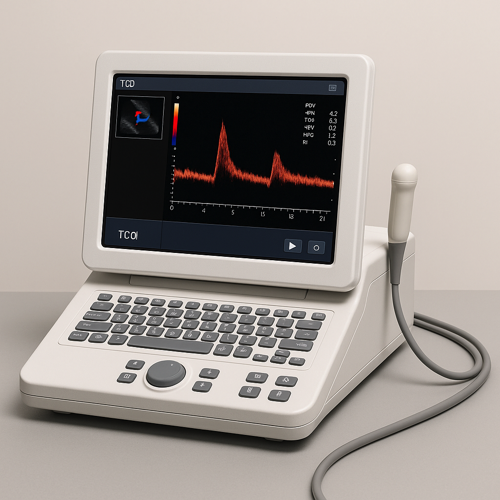Transcranial Doppler Technology and the Growing Need for Portable Devices in Clinics and Hospitals
In modern medicine, rapid and accurate assessment of cerebral blood flow is critical for diagnosing and managing neurological and cardiovascular conditions. Transcranial Doppler (TCD) ultrasound has emerged as a powerful, non-invasive technology that measures cerebral blood flow velocity in real time.
While TCD has been in clinical use for several decades, the growing demand for portable, user-friendly systems is reshaping its role in hospitals and private clinics alike.
What is Transcranial Doppler?

Transcranial Doppler is a specialized ultrasound technique used to evaluate the blood flow in the major basal intracranial arteries. By directing high-frequency sound waves through the thin portions of the skull, TCD can measure the velocity and direction of blood flow in arteries such as the middle cerebral, anterior cerebral, posterior cerebral, and basilar arteries.
This technology is widely applied in the detection and monitoring of:
- Cerebral vasospasm after subarachnoid hemorrhage
- Stroke and transient ischemic attack (TIA) risk assessment
- Sickle cell disease monitoring in children
- Embolic signals during cardiovascular surgery
- Cerebral autoregulation and brain perfusion studies
Its real-time, bedside nature makes TCD especially valuable for critical care and intraoperative monitoring.
Why Portability Matters
Traditionally, TCD machines were large, stationary units, often confined to neurology departments or intensive care units. However, with increasing awareness of the importance of rapid neurological assessment, there is a strong clinical push toward portable Transcranial Doppler devices.
The benefits of portability include:
- Accessibility
Portable TCDs can be used in smaller clinics, rural healthcare centers, and emergency settings where large equipment is not feasible. - Point-of-care diagnostics
Physicians can bring the device directly to the patient’s bedside, reducing delays in diagnosis. - Emergency response
In cases of suspected stroke or traumatic brain injury, portable TCDs can provide rapid, critical information before transferring patients to specialized centers. - Cost-effectiveness
Portable systems allow private clinics to adopt advanced neurodiagnostic technology without the need for large, specialized infrastructure. - Telemedicine integration
Many modern portable TCDs can connect to digital platforms, enabling remote interpretation by neurologists and expanding access to expertise.
Applications in Private Clinics and Hospitals
For private clinics, portable TCD systems open new possibilities for offering advanced diagnostic services that were once restricted to tertiary hospitals. Neurologists, cardiologists, and hematologists can integrate TCD into routine patient evaluations, particularly for stroke prevention and monitoring chronic conditions like sickle cell disease.
In hospitals, portable TCDs improve workflow efficiency by reducing patient transfers between departments, accelerating time-to-diagnosis in emergency units, and enhancing intraoperative monitoring in surgical theaters. They also support broader adoption of neurocritical care protocols, particularly in institutions without a full-scale neurology department.
The Future of Transcranial Doppler Technology
As medical imaging evolves, next-generation portable TCD devices are becoming smaller, more accurate, and AI-assisted, making them easier to use even by non-specialists. Integration with cloud-based platforms and electronic medical records will likely expand the reach of TCD beyond specialized neurologists to general practitioners and emergency medicine teams.
Ultimately, the democratization of TCD technology through portability has the potential to save lives by enabling earlier detection of cerebrovascular risks and providing critical data in time-sensitive scenarios.
Transcranial Doppler technology remains an essential tool in modern medicine for evaluating cerebral hemodynamics. With the rise of portable systems, its use is expanding beyond specialized hospital units into private clinics, emergency departments, and remote healthcare settings. This shift reflects a broader trend in healthcare: bringing advanced diagnostic technologies closer to patients, improving access, and ultimately enhancing outcomes in neurological and cardiovascular care.